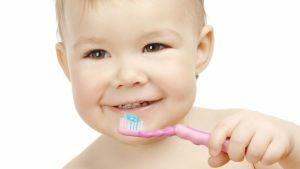 With the advent of a baby in a young child's home, there are a lot of questions about care, including the oral cavity of crumbs.
With the advent of a baby in a young child's home, there are a lot of questions about care, including the oral cavity of crumbs.
"Is it necessary to take care of the milk teeth, if very soon they will be replaced by permanent teeth?" - some mothers will be surprised. After all, the kid does not yet eat solid food, does not drink tea and sweet fizzy drinks. .. Hence, the risk of caries is minimal.
The answer of pediatricians and children's dentists is unequivocal: it is necessary to care for the first teeth, and even without fail.
After all, even in a milk formula or mother's milk contains carbohydrates, which have a negative effect on the delicate enamel. And the health of permanent teeth largely depends on the quality and regularity of care of the oral cavity of the child from the first days of his life.
In addition, the correct structure of the teeth and the bite of the baby are most directly related to his diction in the future.
The health of the digestive system depends on the condition of the dairy cutters, because the quality of the baby will chew firm foods, the stomach will work so well. Yes, and a radiant, snow-white smile adorns the snub-nosed babies.
From the above arguments it can be concluded that the prevention of early caries by almost 80% guarantees the health and beauty of the child's teeth in the future.
How to properly brush your teeth for children? What points should I pay special attention to? With answers to these and other exciting questions, we suggest you read below.
Contents of
- Hygiene of early does not happen
- How to brush your teeth a year-old child
- How to brush your teeth for older children
- When is it necessary to teach a child to self-hygiene?
- How to teach a child to brush his teeth without tears and hysterics?
Hygiene of the early does not happen
Many parents are worried when it is necessary to begin to clean the child's teeth and when to teach the child to do it themselves. 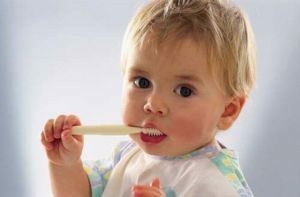
According to children's dentists, you need to look after the mouth cavity from the first days of his life. Even while there are no prerequisites for the appearance of the first teeth, it is necessary to gently wipe the gums with boiled water at room temperature with a special tampon.
To do this, wind on the index finger of the hand a small piece of gauze or bandage and gently, with tangent movements rub the sky, gums, tongue and area behind the cheeks. Or you can buy special cleaning napkins in the pharmacy for these purposes.
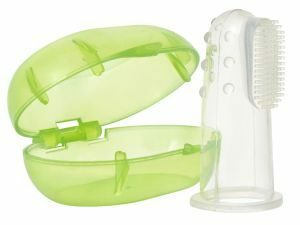 This procedure is necessary after each meal and before bedtime. What is this for? The fact is that sour or fermented remnants of a mixture or milk in the child's mouth can penetrate into the gum tissue itself, thereby provoking destructive processes when forming incisors that have not yet appeared.
This procedure is necessary after each meal and before bedtime. What is this for? The fact is that sour or fermented remnants of a mixture or milk in the child's mouth can penetrate into the gum tissue itself, thereby provoking destructive processes when forming incisors that have not yet appeared.
Of course, during such manipulations, the kid can display notes of protest in the form of screaming, squealing, tears or repulsive movements. In no case should parents stop. Soft, but persistent training in the process of cleaning teeth is the key to careful treatment of them in adulthood.
Already in 5-6 months of the child may seem the first teeth. It is at this time that the ejecting reflex practically disappears. In such a "serious" age for cleaning teeth, it is already desirable to use a silicone brush-fingertip or a classic children's brush with soft bristles.
With the help of such devices, you can not only eliminate the formed plaque, but also make an easy massage of the gums, which is very useful for cutting incisors. The need for using toothpaste at this age does not yet exist.
How to brush a tooth for a one-year-old child
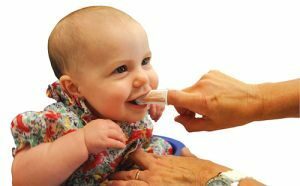 Some mothers do not have reliable information, when you can apply a toothbrush for cleaning your teeth, and postpone the time of acquaintance of the baby with such a necessary accessory at least up to 2-3 years. This approach is wrong at the root.
Some mothers do not have reliable information, when you can apply a toothbrush for cleaning your teeth, and postpone the time of acquaintance of the baby with such a necessary accessory at least up to 2-3 years. This approach is wrong at the root.
A one-year-old baby has a habit of trying everything "to taste", and sometimes not the purest objects. Naturally, the process of reproduction of bacteria in the oral cavity in this case can not be avoided.
Therefore, a child of this age especially needs careful and systematic care of the oral cavity, regardless of how many teeth it already seemed.
What are the criteria for the first child toothbrush:
- , it is desirable that the toothbrush accessory has a special silicone restriction ring, the purpose of which is to minimize the risk of penetrating the brush directly into the oral cavity or larynx;
- short handle with special anti-slip inserts;
- neat brush contour, small head;
- soft bristles of different length, made of synthetic materials;
- the presence of rubber studs on the back of the head, designed for gum massage and tongue cleaning;
- is an attractive, colorful design.
Now, as for the actual process of brushing your teeth. Of course, the kid at such a young age is not yet able to cope with the task assigned to him, so the presence and assistance of adults is simply necessary.
So, how to properly brush your teeth for a year or more:
- Place a temporary "baby's workstation" in the bathroom in front of the mirror-a small stool or a stool. The convenient position of the child during the hygiene procedure will facilitate the process to both parties.
- Well moisten the brush in the room temperature water and gently swipe the baby's teeth. Repeat the manipulation several times.
- The brush should be held correctly by the , at an angle of 45 degrees, and the movements from the gum to the tooth edge. Do not forget that the circular movements of the brush can damage the enamel. The need to use toothpaste at this age should be decided by each parent independently.
- On a personal example, show , how to properly rinse the mouth of and ask the crumb to repeat your manipulation.
- Rinse the brush and put it in a special cup.
How to properly brush your child's teeth - a video that will be useful for children and their parents:
How to brush your teeth for older children
At the age of two, a child can take an interest in independent oral care. And it is already at this stage it is desirable to teach the baby to brush his teeth with a special baby toothpaste.
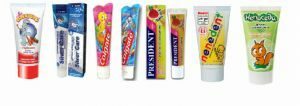 In order to reject all doubts about the quality of toothpaste, it is better to buy it in a pharmacy, having previously read the annotation.
In order to reject all doubts about the quality of toothpaste, it is better to buy it in a pharmacy, having previously read the annotation.
What criteria should it meet:
- minimum content or total absence of fluoride paste in the composition of fluoride paste, - ingestion of fluoride-containing products by the child, even in a minimal amount, increases the risk of fluorosis occurrence;
- complete absence of synthetic perfume and sodium lauryl sulfate ;
- good protection against caries ;
- minimum abrasiveness , although chalk and soda as part of the paste should provide a good cleaning effect, their effect on the enamel of children's teeth is too aggressive.
Of course, a two-year-old will not be able to clean his teeth correctly and qualitatively, especially since the first time. Do not scold him and do not interfere with the process.
Conversely, gently holding it with a toothbrush handle, point it in the right direction, tell how to correctly carry out movements, praise it.
Helping the child to care for the right side of the oral cavity, it is advisable to stand on the left and manipulate the left hand, and behind the left side - respectively, the right and right hand. After a while the child will remember the algorithm of the procedure and will brush his teeth himself.
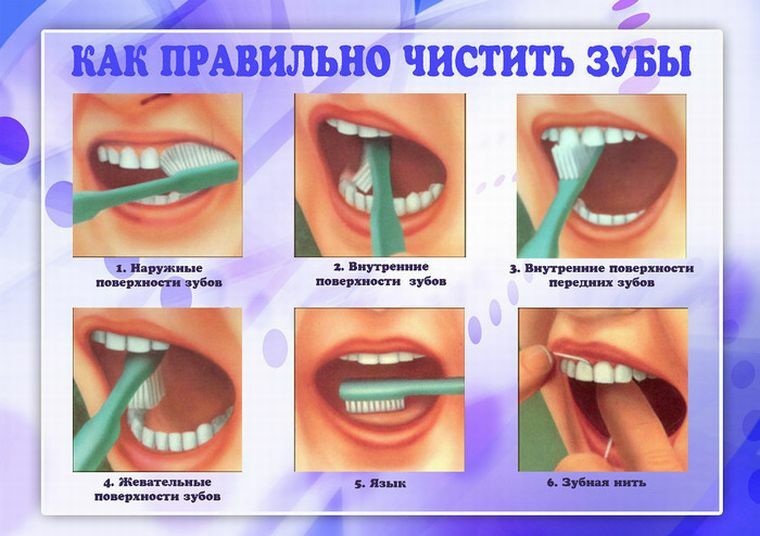
When is it necessary to teach a child to self-hygiene?
It is advisable to teach a child to clean his teeth from the age of 3 only.
At the age of 5-7 years, the bite changes, and the baby teeth gradually replace the first permanent ones.
According to dentists, it is at preschool age that a child should know the basic rules of cleaning teeth and be able to apply them in practice.
Namely:
- rinse the toothbrush with warm water at room temperature;
- correctly and in the right amount squeeze toothpaste from the tube;
- confidently own a "standard method" of tooth cleaning, consisting of vertical, horizontal and circular movements;
- at the end of the procedure thoroughly rinse the mouth with warm water.
How to teach a child to brush his teeth without tears and hysterics?
It is impossible to teach a child to brush their teeth by themselves, if parents themselves often neglect this hygienic procedure. You want to instill a useful habit in your child - demonstrate your own example.
In order for the baby to brush his teeth with interest and pleasure, you need to bring the elements of the game into this process.
For example, offer a child to brush his teeth under the accompaniment of a favorite song or poem. Or arrange a family competition, who will brush their teeth faster and better. Of course, the winner of the game should be the youngest member of the family.
There are situations where only with one kind of toothbrush the baby begins uncontrollable hysteria. 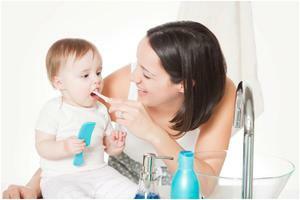
The reason for this may be the child's early learning to the daily hygienic procedure or the delayed memory of the discomfort that he experiences during the cleaning process.
What should parents do in this case? First of all, does not need to accustom a child to such a procedure violently , intimidating him with harmful microbes or blackmailing the ban on daily walks. Even if the child refuses, very gently and gently call for personal hygiene.
Think, perhaps such a protest is caused by a child's personal rejection of a particular toothbrush or paste. Invite the child to take a walk in the shops and choose the dentifrice to his liking.
Do not forget that early prevention of tooth decay and daily oral hygiene does not exclude the need to visit the dental office at least twice a year. A professional examination will help identify emerging or existing problems and correct them in time.
